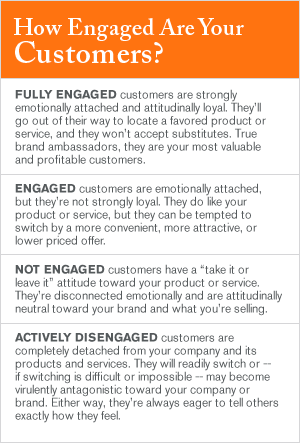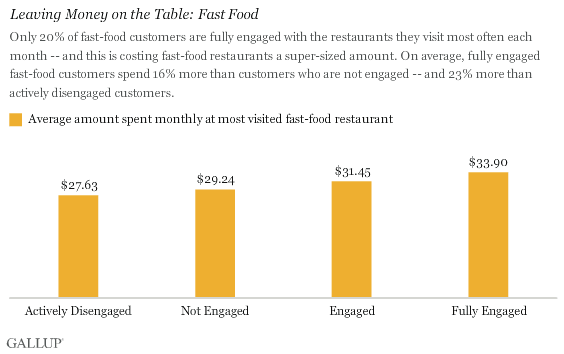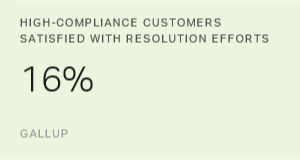We all know these are difficult economic times. Consumers' priorities have shifted dramatically -- and that means dramatic changes for many businesses. Gallup has analyzed consumer behavior in many different sectors of the economy throughout the recession. What we've discovered is a foundational shift in the way people are spending and saving money. Ignoring this "new normal" puts companies in peril.
Spending is down significantly in both fast-food and casual dining.
According to Gallup research, 46% of Americans say they're spending less than they were a year ago. About 1 in 10 (11%) see their change in spending as temporary, and they intend to start spending more in the future. But 35% say their spending changes are permanent.
So it's time to face the new consumer spending facts: Americans don't believe they're going back to the way things were, regardless of when and how quickly the economy recovers. As a result, consumers are weighing tough choices about everything -- and every brand -- before they buy. Brands that embrace this change and find ways to engage their customers will outperform their competitors now and as the economy improves.
To find out more about how the "new normal" is affecting consumer choices, Gallup asked roughly 25,000 consumers about their views on the economy, their spending, and their brand relationships. We wanted to learn more about how they're spending their money, which brands they choose, why they make the choices they do, and how engaged they are with the brands they're using or considering.
We focused on several industries, among them restaurants. We uncovered a few facts that should concern those in the restaurant industry:
- Spending is down significantly in both fast-food and casual dining.
- Customer engagement -- the level of emotional attachment your customers have with your brand -- predicts frequency of patronage and spending.
- Overall customer engagement levels for fast-food and casual dining are mostly below average compared to Gallup's database of general customer engagement.

Over the past decade or so, Gallup has been researching customer engagement. We've found, over and over, that engaged customers spend more, return more often, and are less price sensitive -- and they encourage others to patronize their favorite businesses too. Companies that can engage their customers gain a competitive advantage over those that can't.
And research into consumer buying reveals a finding that is particularly important to the restaurant industry: Purchasing an experience does more to create well-being than buying a product, even long after the experience has ended. That's likely because experiences involve relationships and memories that can be relived, while the novelty of material purchases wears off over time. Think about it: You probably have more fond memories about your last vacation than you do about the last car you bought, even though it's likely that the car cost more and lasted longer.
These two findings -- that creating emotional connections with customers can be a competitive advantage for businesses and that purchasing experiences promotes feelings of well-being more effectively than purchasing things -- offer powerful insight for all businesses, but particularly for restaurants. Restaurants that create a positive dining experience can engage customers and boost their well-being -- and both feelings could motivate customers to return soon and more often.
How can restaurants promote this kind of dining experience? Simply put, they need to appeal to diners' hearts as well as their stomachs.
Fast food
When it comes to fast food, 35% of customers say their spending has declined since last year, and of those customers, 54% say that not only are they spending less now, they always will. To entice these tight-fisted consumers, it's imperative for fast-food restaurants to craft a tightly focused brand promise.
According to Gallup's analysis, the most powerful driver of engagement in fast food is "being treated as a valued customer," followed by "the warmth of the greeting" and "the taste of the food." Yet most diners don't feel they're being treated and fed well. Gallup's analysis shows that 27% of restaurant customers are fully engaged, and 20% are actively disengaged. Among fast-food customers, though, 20% are fully engaged, and 31% are actively disengaged.
If only 20% of fast-food customers are fully engaged, that means 80% are being left in the cold -- and it's costing fast-food restaurants a fortune. On average, a fully engaged fast-food customer spends 16% more than a customer who is not engaged and 23% more than an actively disengaged customer.

In general, fast-food restaurants aren't good at engaging customers, but there is a standout. Almost two-thirds (65%) of Fast Food A's customers are fully engaged, which is among the highest percentage of any business Gallup has ever studied. It's no surprise, then, that Fast Food A also claims the highest frequency of visits and highest spending among patrons in this category.
On the other end of the spectrum, the fast-food chain that's least successful at engaging customers is Fast Food J: Only 9% of its customers are fully engaged, while 48% of its customers are actively disengaged. That means about half of its consumers would prefer to eat almost anywhere else, but they select this brand in spite of how they feel about it because of low cost, high convenience, or both.

Casual dining
Gallup found that 46% of American casual dining patrons have reduced their spending, and of those customers, 46% say they don't plan to change their ways. That's not good news for restaurants in this category. Casual diners are more likely than fast-food customers to be engaged with a restaurant brand. In this category, 26% of patrons are fully engaged, while 35% are not engaged, and 21% are actively disengaged, and they have very little emotional connection to a brand.
Gallup's analysis also suggests that restaurants in this segment are leaving a significant amount of money on the table. On average, fully engaged casual dining customers spend 12% more than customers who are not engaged and 25% more than actively disengaged customers.

Moreover, the drivers of engagement for casual dining patrons are different than those for fast-food customers. Casual diners say their most powerful driver of engagement is "value for the money," closely followed by "being treated like a valued customer" and "taste of the food." As the graphic below shows, customer engagement scores for casual dining restaurants tend to cluster together. That sort of grouping indicates that not only is customer engagement weak among these restaurants, but the brands in this category are not differentiating themselves from their competitors.
In the casual dining category, Casual Dining A is the leader in engaging its customers: 42% of its customers are fully engaged, a solid 16 percentage points higher than the average in this category (26%). On the other end of the spectrum is Casual Dining J; 18% of its customers are fully engaged, while 27% of its customers are actively disengaged.

The overall low level of customer engagement for casual dining restaurants -- and for fast-food restaurants as well -- is disturbing news for marketing and advertising executives who spend enormous amounts of money each year promoting their brands. But that brings up a central tenet of brand management in any economy: The brand and its marketers can make promises, but it's up to the individual stores -- and their employees -- to deliver on them. If a restaurant's employees aren't delivering a positive, memorable, and engaging dining experience, customers will leave without the boost to their well-being that could encourage them to return soon, and more often.
It's important to focus on food. Taste is key in driving engagement and repeat business.
Dinner is served
So what are the most engaging restaurants doing right -- and, by implication, what are the least engaging restaurants doing wrong? Consumers say that the taste of the food is extremely important. So it may seem as if the biggest opportunity for engaging customers lies on the plate. But making wholesale menu changes is expensive and difficult -- just ask Domino's Pizza.
Perhaps offering healthy food options will be the key to drawing in and engaging customers in the future. The analysis suggests that healthier food options are likely to become more important in both dining categories, but they're not a vital consideration for consumers yet. Right now, this is less important than other key drivers, including taste.
When it comes to promoting customer engagement, the customer experience and the emotions it engenders -- being valued, being greeted warmly, being fed well by pleasant servers -- are more important to customers than anything else. (They're even more important than other things that diners say they care about, including healthy eating choices, speed of service, value for the money, and availability of nutritional information -- even cleanliness.)
How, then, can restaurants tempt wary consumers to open their wallets? One of the best ways to change customer behavior, it seems, is to alter employee behavior. Employees can spark engagement -- or smother it. Employees can be more effective in engaging customers than expensive advertising campaigns: The key is treating diners as though they're valued customers and giving them a warm greeting. When fast-food joints, for example, serve good food, offer value for the dollar, treat customers right, and greet them warmly, they can create magic on the customer engagement chart.
Insight to chew over
What else has Gallup learned from fast-food and casual dining customers? Here are some more crucial insights:
- Poor execution of brand promise destroys brands. Franchisees don't want to hear this, but it's true. Consider using engagement as a way to allocate discretionary funds to top performers.
- It's important to focus on food. Taste is key in driving engagement and repeat business. Healthy eating options are an emerging trend that restaurateurs should monitor. Right now, the food on the menu needs to be consistent with the brand promise. For many brands, offering healthy food options could be an opportunity for future growth.
Making the changes needed to engage customers will take time and money. Both are tight in this industry -- restaurants operate on a very slim margin. But so do consumers. And that margin, the analysis shows, isn't going to loosen up for many Americans any time soon.
Especially when times are tough, the best option is to give customers what they want: an emotionally engaging experience and good food. The restaurants that do this now, when the economy is poor, are the ones that will find themselves best positioned when consumers start dining out again.
Additional Reading
Carter, T.J., & Gilovich, T. (2010). The relative relativity of material and experiential purchases. Journal of Personality and Social Psychology, 98(1), 146-159.
Van Boven, L., & Gilovich, T. (2003). To do or to have? That is the question. Journal of Personality and Social Psychology, 85(6), 1193-1202.
Survey Methods
Results are based on a Gallup Panel study and are based on mail and web surveys completed by 24,842 national adults, aged 18 and older, conducted in March and April 2010. Gallup Panel members are recruited through random selection methods. The panel is weighted so that it is demographically representative of the U.S. adult population. For results based on this sample, one can say with 95% confidence that the maximum margin of sampling error is ±1.0 percentage points. Margins of sampling errors vary for individual subsamples. In addition to sampling error, question wording and practical difficulties in conducting surveys can introduce error or bias into the findings of public opinion polls.
